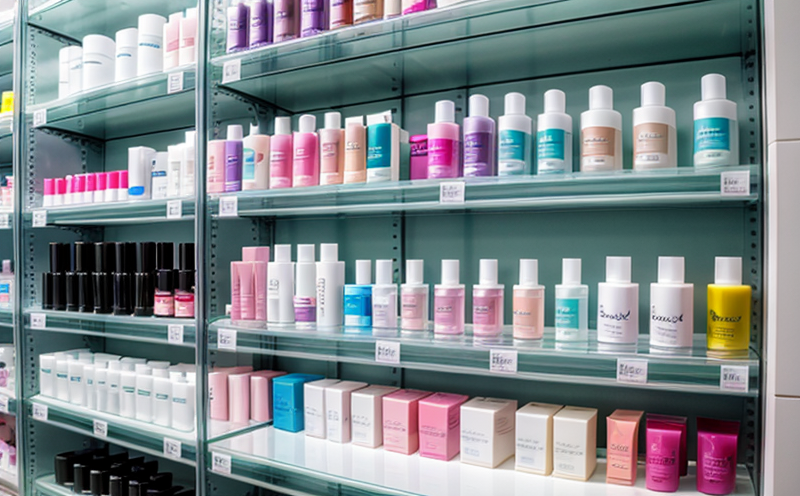UV Stability Testing for Cosmetic Products
UV Stability Testing for Cosmetic Products is a critical step in ensuring that cosmetic formulations remain stable and meet quality standards during their shelf life. Exposure to ultraviolet (UV) light can lead to degradation of pigments, fragrances, and other components, potentially affecting the product's appearance and efficacy over time.
The process involves exposing cosmetic samples to controlled UV radiation for extended periods under conditions that simulate real-world exposure environments. This helps in predicting how a cosmetic formulation will perform in terms of color retention, texture stability, and overall quality during storage and use. By conducting this test early in the development phase, manufacturers can identify any potential issues before mass production begins.
The primary goal is to assess whether UV light has an adverse effect on the chemical composition or physical properties of a cosmetic product. Factors such as color change, loss of active ingredients, and alteration in formulation structure are closely monitored during testing. This information is crucial for developing products that meet regulatory requirements while also maintaining consumer satisfaction.
International standards like ISO 17652-3:2018 provide guidelines on how to conduct UV stability tests effectively. These protocols ensure consistency across different laboratories and help maintain high-quality control throughout the manufacturing process. Understanding these standards allows us at Eurolab to deliver accurate results that align with global expectations.
During testing, it's essential to consider not just the chemical makeup but also how various elements interact within a formulation. For instance, certain pigments may react more intensely than others under UV light exposure; therefore, individual components need careful evaluation.
| Use Case | Description |
|---|---|
| Making Informed Decisions | Determining the best packaging materials to protect products from UV degradation. |
| Ensuring Compliance | Avoiding non-compliance with regulations regarding cosmetic safety and efficacy. |
| Predicting Product Lifespan | Understanding how long a product can remain effective in its intended form after exposure to UV light. |
| Evaluating Ingredient Stability | Identifying which ingredients are most susceptible to photodegradation and optimizing formulations accordingly. |
In summary, UV stability testing ensures that cosmetic products maintain their intended qualities throughout their shelf life. With careful preparation, accurate measurement techniques, and adherence to international standards, Eurolab provides reliable data to support informed decision-making processes in the industry.
Eurolab Advantages
At Eurolab, we pride ourselves on delivering unparalleled expertise and precision when it comes to UV stability testing for cosmetic products. Our team consists of highly skilled professionals who understand the nuances of this specialized field, ensuring that every aspect of your product is thoroughly evaluated.
- Comprehensive Analysis: We offer a wide range of analytical services tailored specifically towards cosmetics, including physical and chemical analysis, microbiological testing, packaging integrity checks, and more.
- Innovative Solutions: Leveraging cutting-edge technology allows us to stay ahead in terms of methodology development and application, providing solutions that meet current and future challenges facing the industry.
- Regulatory Knowledge: Our experienced staff keeps up-to-date with all relevant regulations so you can be confident about meeting legal requirements at every stage of your project lifecycle.
- Quality Assurance: From initial consultation through final report generation, we maintain strict quality assurance practices that guarantee accuracy and reliability in our findings.
Choose Eurolab for all your UV stability testing needs. Trust us to provide the insights necessary for successful product development and launch strategies.
International Acceptance and Recognition
UV stability testing for cosmetic products is widely recognized globally due to its importance in ensuring product quality, safety, and effectiveness. Various international standards have been established to guide laboratories performing these tests consistently worldwide. Among them are:
- ISO 17652-3:2018: This standard specifies the procedures for determining the photostability of cosmetic products using accelerated testing methods.
- ASTM D4994-14e1: Provides guidelines on testing the resistance to ultraviolet light of liquid and solid materials used in packaging containers.
- EN 15206:2017: Describes the procedure for assessing the impact of visible radiation, including UV-A and UV-B rays, on colorfastness properties of textiles.
- IEC 62391-14:2018: Covers requirements related to photostability testing of electronic devices exposed to natural sunlight or artificial sources.
The acceptance and recognition of these standards vary depending on the country's regulatory framework. However, compliance with internationally accepted norms enhances credibility and ensures that your products meet international quality expectations.
Use Cases and Application Examples
| Use Case | Description |
|---|---|
| Packaging Material Selection | Determining the most suitable packaging material that can effectively shield cosmetics from UV damage. |
| Ingredient Optimization | Evaluating different ingredients' susceptibility to UV-induced changes and optimizing formulations based on those findings. |
| Product Quality Assurance | Verifying the stability of a product over time, ensuring it meets both initial specifications and ongoing quality standards. |
| Regulatory Compliance | Safeguarding against non-compliance with local or international regulations pertaining to cosmetic safety and efficacy. |
| Packaging Design Optimization | Improving the design of packaging to enhance protection from UV light while also considering other factors like aesthetics and functionality. |
| Product Lifespan Prediction | Predicting how long a product can remain effective in its intended form after exposure to UV light, aiding in better planning for marketing campaigns and inventory management. |
These use cases highlight the significance of conducting thorough UV stability tests on cosmetic products. By doing so, manufacturers can ensure their products not only meet regulatory standards but also provide consistent quality and satisfaction to consumers.





